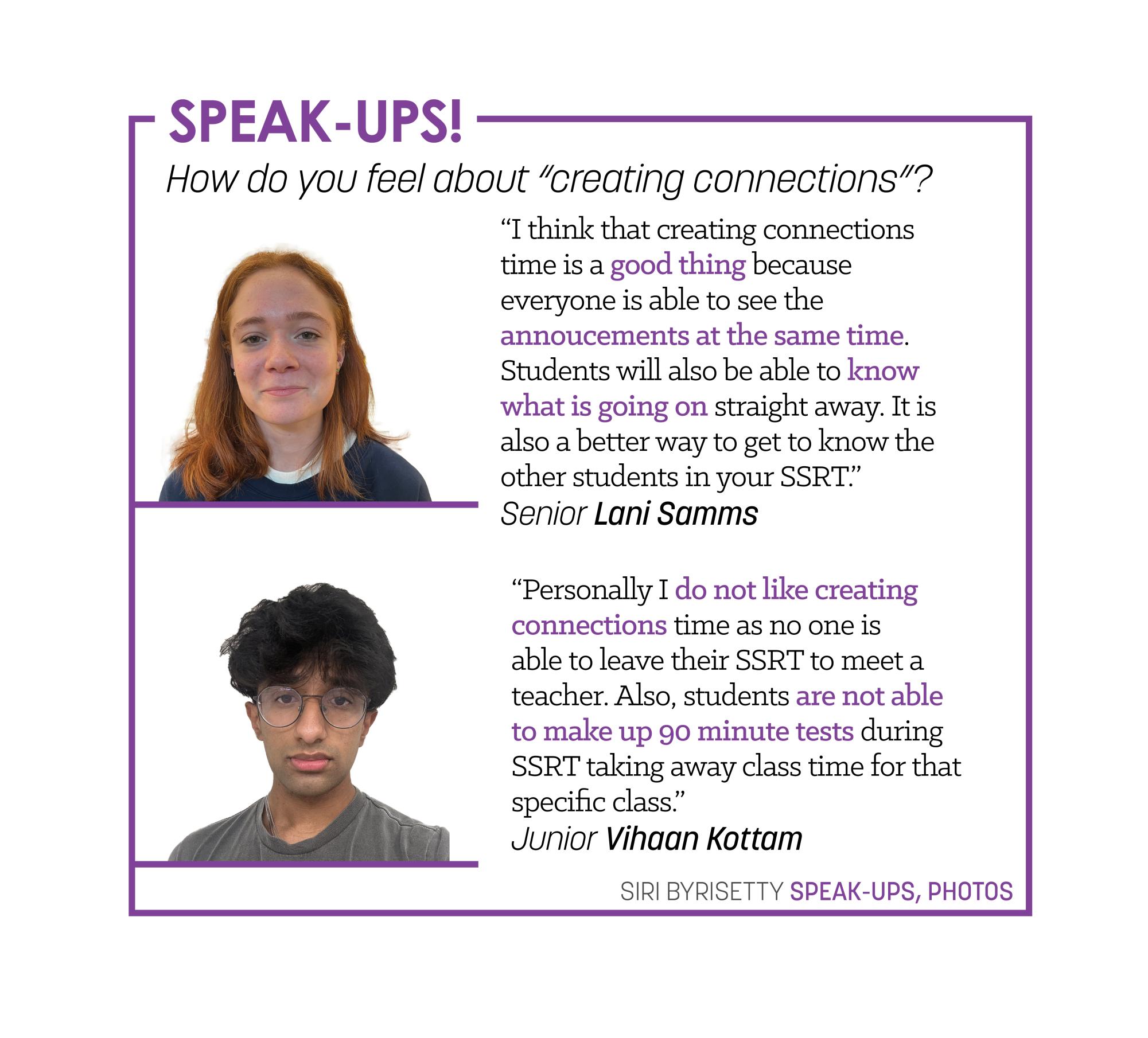In the beginning of the school year, the CHS administration announced a new policy that would confine students in their SSRT room during the first 30 minutes of the period. Designed to keep students in the SSRT room, the mandatory “Creating Connections (CC)” period serves as a time to make school-wide announcements while ensuring maximum attendance.
Even with the benefits of increased attendance during this period, it is pivotal for the administration to consider the significance of losing 30 minutes of work time during SSRT. Historically, students have used this time to take make-up tests, whether they were absent the day of the test or they felt the need to retake it. The 90 minutes matched the time their classmates had in completing the exam. Now, with the tighter enforcement of the CC session, students can only make up the test in the span of 60 minutes and sometimes less as students must walk to their respective classes after CC ends. Students will therefore need to set aside multiple days to make up their tests, which is hard for students who have time commitments in other activities during SSRT.
Of course, it could be argued that students could make up the tests either in the mornings or after school. However, with students engaged in clubs, athletics, and other extracurriculars, this may not be a possible solution for many. Additionally, students may have circumstances where they do not have transportation available for before and after school activities. Do these students deserve to be excluded from the opportunity to complete assessments during SSRT?
This inconvenience will not only affect students but also teachers. Tests at CHS are usually structured to take the entire 90 minutes of the class period. However, with this new policy put into place, teachers will have to change the formatting of the tests so it can take two SSRT days to finish instead of one. Alternatively, teachers may create a 60 minute test so it could fit within the full time of SSRT. This could cause teachers to decrease the amount of content in the tests, which could offer students unfair advantages.

The detrimental effects of CC are not just limited to exams. Students meeting to work on group activities will also be restricted to the 60 minutes following the CC period. The time that students have to ask teachers questions for their classes is also reduced.
Overall, the HiLite staff believe the negatives outweigh the positives when it comes to implementing the CC session during SSRT. The CC session does succeed in making sure all students hear school-wide announcements. However, CC has various unintended consequences, preventing students from allocating their full 90 minutes of SSRT efficiently. Even without the CC session, CHS administrators could find other ways to communicate important information without interfering with the affairs of the student body. We would like to see the administration loosen the policy of CC or terminate it entirely.

































![AI in films like "The Brutalist" is convenient, but shouldn’t take priority [opinion]](https://hilite.org/wp-content/uploads/2025/02/catherine-cover-1200x471.jpg)










































![Review: “The Immortal Soul Salvage Yard:” A criminally underrated poetry collection [MUSE]](https://hilite.org/wp-content/uploads/2025/03/71cju6TvqmL._AC_UF10001000_QL80_.jpg)
![Review: "Dog Man" is Unapologetically Chaotic [MUSE]](https://hilite.org/wp-content/uploads/2025/03/dogman-1200x700.jpg)
![Review: "Ne Zha 2": The WeChat family reunion I didn’t know I needed [MUSE]](https://hilite.org/wp-content/uploads/2025/03/unnamed-4.png)
![Review in Print: Maripaz Villar brings a delightfully unique style to the world of WEBTOON [MUSE]](https://hilite.org/wp-content/uploads/2023/12/maripazcover-1200x960.jpg)
![Review: “The Sword of Kaigen” is a masterpiece [MUSE]](https://hilite.org/wp-content/uploads/2023/11/Screenshot-2023-11-26-201051.png)
![Review: Gateron Oil Kings, great linear switches, okay price [MUSE]](https://hilite.org/wp-content/uploads/2023/11/Screenshot-2023-11-26-200553.png)
![Review: “A Haunting in Venice” is a significant improvement from other Agatha Christie adaptations [MUSE]](https://hilite.org/wp-content/uploads/2023/11/e7ee2938a6d422669771bce6d8088521.jpg)
![Review: A Thanksgiving story from elementary school, still just as interesting [MUSE]](https://hilite.org/wp-content/uploads/2023/11/Screenshot-2023-11-26-195514-987x1200.png)
![Review: "When I Fly Towards You", cute, uplifting youth drama [MUSE]](https://hilite.org/wp-content/uploads/2023/09/When-I-Fly-Towards-You-Chinese-drama.png)
![Postcards from Muse: Hawaii Travel Diary [MUSE]](https://hilite.org/wp-content/uploads/2023/09/My-project-1-1200x1200.jpg)
![Review: "Ladybug & Cat Noir: The Movie," departure from original show [MUSE]](https://hilite.org/wp-content/uploads/2023/09/Ladybug__Cat_Noir_-_The_Movie_poster.jpg)
![Review in Print: "Hidden Love" is the cute, uplifting drama everyone needs [MUSE]](https://hilite.org/wp-content/uploads/2023/09/hiddenlovecover-e1693597208225-1030x1200.png)
![Review in Print: "Heartstopper" is the heartwarming queer romance we all need [MUSE]](https://hilite.org/wp-content/uploads/2023/08/museheartstoppercover-1200x654.png)




